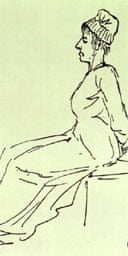Artist: Jacques-Louis David (1748-1825) was not simply one of the crowd when he sketched Marie Antoinette on her way to the guillotine on October 16, 1793. David, an eminent Jacobin and ally of Robespierre, voted for her death. He was the Revolution's chief artist, costume designer, ritual planner. After knocking off this sketch, David had important business that day - a ceremony to unveil his icon of Revolutionary martyrdom, Marat Assassinated.
He was a great artist, arguably the father of modernism, undoubtedly the consul of neo-classicism. David shaped the intense, apocalyptic mood of late-18th-century culture with paintings rhetorically reviving ancient Roman civic virtues, such as The Oath of the Horatii (1784-5). As France came closer to cataclysm, David's imagery of sacrifice became more deathly. His 1787 painting The Death of Socrates anticipates what he is later said to have promised Robespierre: "If you drink hemlock, I shall drink it with you."
Subject: Marie Antoinette went to her death well; while the crowd's responses ranged from sympathy to spitting, she remained impassive until she reached the scaffold.
Distinguishing features: Portraiture has an affinity with death, but this is something unique - at once a callous observation and... what? It seems sympathetic, nothing to do with the grotesque vilifications of Marie Antoinette circulating in word and image. It depicts her last moments as miserably human, unglamorous to a degree that may embody a Revolutionary joy in the destruction of rococo fripperies. As she sits there, hair cut, a few strands poking out of her bonnet, her nose big, her mouth a grim line, she is the opposite of idealised royalist portraiture.
But there is a determination to the way she sits without looking up. This drawing is an acknowledgement of the Revolution's violence, in which David is complicit. David is an honest extremist. He believes in the inevitability of this execution so absolutely that he can stand back and feel a tweak of empathy.
Inspirations and influences: David inaugurated a public seriousness in French art that can be traced through Géricault's Raft of the Medusa and Delacroix's Liberty Leading the People.
Where is it? The Louvre, Paris.
